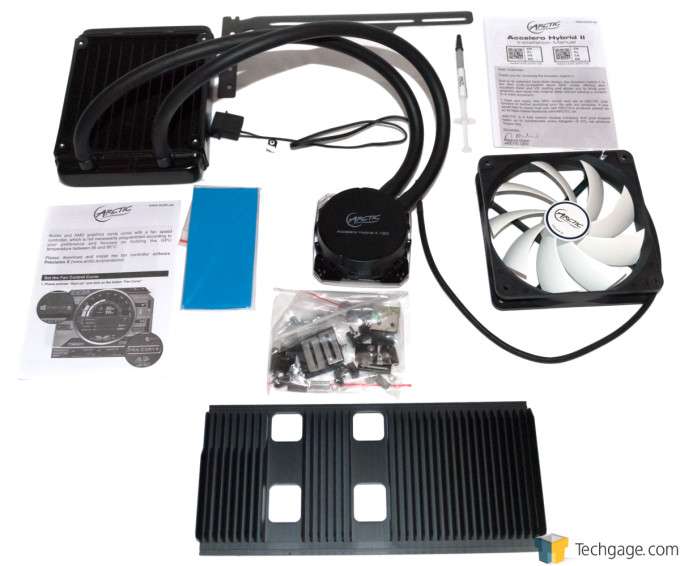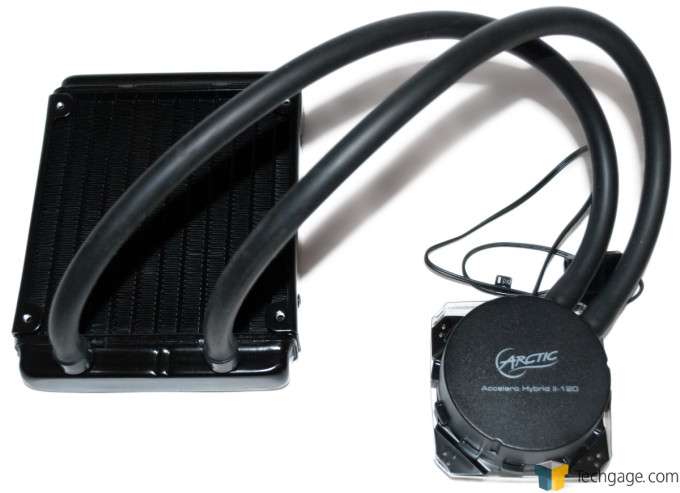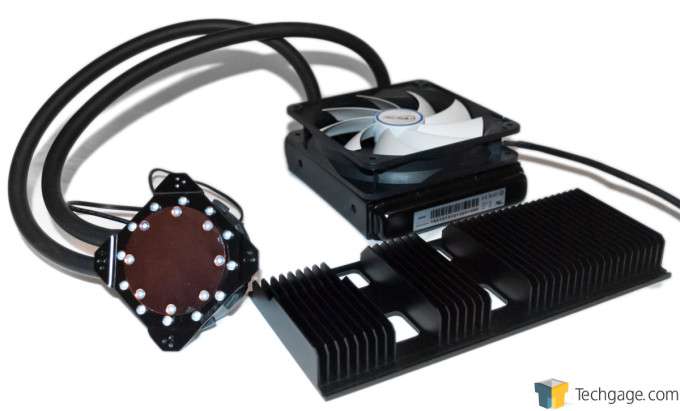- Qualcomm Launches Snapdragon 4 Gen 2 Mobile Platform
- AMD Launches Ryzen PRO 7000 Series Mobile & Desktop Platform
- Intel Launches Sleek Single-Slot Arc Pro A60 Workstation Graphics Card
- NVIDIA Announces Latest Ada Lovelace Additions: GeForce RTX 4060 Ti & RTX 4060
- Maxon Redshift With AMD Radeon GPU Rendering Support Now Available
Ice-cold Temperature Killa: Arctic Accelero Hybrid II-120 GPU Cooler Review

There’s no question about it: AIO water cooling solutions are here to stay. They’ve been around for CPUs; but what about GPUs? Arctic has that base covered, and it sent us its Accelero Hybrid II-120 with the unspoken promise that it is superior to any stock cooling solution. But just how good is it?
Page 1 – Introduction
Let’s face it, folks.
No matter how much we might all deny it, we’re all greedy. In our PC enthusiast heart of hearts, we are possessed of an avarice for performance. Sure, some of you may deny it. Some of you might even say, “Hey, I’m happy with what I’ve got. I don’t need more frames-per-second,” or “I’m not chasing those last few degrees Centigrade lower of maximum load temperatures.”
You ain’t foolin’ no one.
I mean, how else would you explain that PC enthusiast syndrome known as “upgrade-itis”? Let’s just be honest here: Isn’t this eternal quest for bigger, better, faster, cooler at the very core of our involvement in this wonderful hobby?
Let’s talk about cooling. In my earliest years as a PC enthusiast, I was obsessed with lowering my components’ temperatures – especially at load – through any means available. With my Opteron CPUs, that even entailed removing the IHS (integrated heat spreader). The payoff, of course, was spectacular, with maximum load temperatures dropping as much as 20ºC. That ultimately meant that I could overclock my Opterons like crazy.
And this was all before I got bit by the water-cooling bug.
These days, I’m a dedicated custom water cooling enthusiast. As such, I must admit to having a bit of a snobbish attitude towards the modern trend for AIO (all-in-one) water cooling solutions. But cooling equipment solutions provider Arctic has given me something of an attitude adjustment.
Behold the Accelero Hybrid II-120.
Arctic’s Accelero Hybrid II-120 is an AIO GPU water cooling solution. Unlike one of Arctic’s competitor’s products which I reviewed earlier this year, the Accelero Hybrid II-120 is a complete solution in one box. The competitor’s product, if you’ll recall, is an adapter that enables CPU-mounted AIO water-coolers to be mounted on a GPU. The Accelero Hybrid II-120, on the other hand, has everything you need to improve your GPU’s temperatures.
Let’s have a look at it, then, shall we?
Here’s everything that comes in the box.
All told, it’s a comprehensive package. Of course you have in the integrated water pump + cooling block + radiator unit. There’s also the 120mm Arctic fan; it’s designed to be connected to your GPU’s 4-pin connector. Also pictured are a couple of baggies for installation hardware. The light blue rectangle is thermal interface material to be used on your GPU’s memory chips and voltage regulators. The big black item on the bottom of the picture is the backside-mounted heat sink, while, partially hidden at the very top is an L-bracket (Arctic calls it a Graphics Card Holder in its instruction manual) that’s used to stabilize the video card installation in a conventional PC chassis. As an aside, I won’t be using this since I’ll be installing this on my test bench, where the motherboard is installed horizontally. Also, Arctic has included a syringe of its highly-regarded MX-4 thermal interface material. Finally, there is a good instruction manual.
Here’s a close-up of the integrated pump + block + radiator unit. The water pump is powered by a 4-pin Molex connector.
This shot shows the bottom of the cooling block as well as the backside heat sink. These represent the bulk of the Accelero Hybrid II-120’s cooling power. The backside heat sink in the foreground is a fairly heavy piece of metal; therefore, when the Accelero Hybrid II-120 is installed in a PC chassis, I highly recommend you use the Graphics Card Holder to help support the graphics card. You wouldn’t want the whole kit and caboodle supported just by the GPU’s PCI-Express connection, for sure.
Support our efforts! With ad revenue at an all-time low for written websites, we're relying more than ever on reader support to help us continue putting so much effort into this type of content. You can support us by becoming a Patron, or by using our Amazon shopping affiliate links listed through our articles. Thanks for your support!







